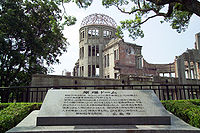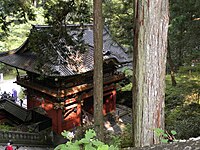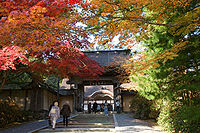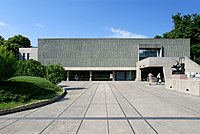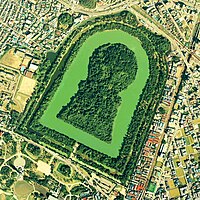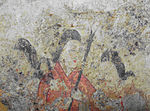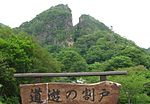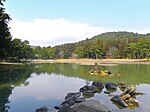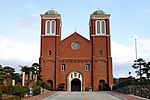World Heritage in Japan
For World Heritage in Japan include (as of 2019) 23 UNESCO World Heritage sites , including 19 sites of World Heritage sites and four of World Natural Heritage. Japan acceded to the World Heritage Convention in 1992, and the first four World Heritage sites were added to the World Heritage List in 1993. The last World Heritage site to date was registered in 2019.
World heritage sites
The following table lists the UNESCO World Heritage Sites in Japan in chronological order according to the year of their inclusion on the World Heritage List (K - cultural heritage, N - natural heritage, K / N - mixed, (R) - on the Red List of World Heritage in Danger ).
![]() Map with all coordinates of World Heritage Sites: OSM
Map with all coordinates of World Heritage Sites: OSM
| image | designation | year | Type | Ref. | description |
|---|---|---|---|---|---|
|
Buddhist shrines of Horyu-ji ( location ) |
1993 | K | 660 | Buddhist temple in Ikaruga city | |
|
Aristocratic seat Himeji-jō ( location ) |
1993 | K | 661 | 17th century castle in Himeji City . | |
| Yakushima cedar forest | 1993 | N | 662 | Forest of crescent fir ( Cryptomeria japonica , also called Japanese cedar ) on the island of Yakushima . | |
| Shirakami beech forest | 1993 | N | 663 | mountainous, pristine forest landscape in Akita and Aomori prefectures . | |
| Monuments and gardens of the Imperial City of Kyoto | 1994 | K | 688 | The world heritage site comprises 17 locations in Japan, which are located in the three cities of Kyoto , Uji and Ōtsu . | |
| Historical villages of Shirakawa-go and Gokayama | 1995 | K | 734 | three historical villages in the Shogawa river valley . | |
|
Peace Memorial in Hiroshima ( location ) |
1996 | K | 775 | a memorial for the first military use of an atomic bomb in Hiroshima Peace Park . | |
|
Itsukushima Shinto Shrine ( location ) |
1996 | K | 776 | Shinto shrine on Miyajima Island with structures built over the water of a bay. | |
| Architectural monuments and gardens of the imperial city of Nara | 1998 | K | 870 | These include: Gangō-ji , Heijō Palace , Kasuga-Taisha , Kasugayama Primeval Forest, Kōfuku-ji , Tōdai-ji , Tōshōdai-ji and Yakushi-ji in Nara | |
| Shrines and Temples of Nikko | 1999 | K | 913 | These include: Toshogu , Futarasan Shrine, and Rinnō-ji in Nikkō | |
| Archaeological Sites of the Kingdom of the Ryukyu Islands | 2000 | K | 972 | on the Ryūkyū Islands | |
| Sacred sites and pilgrimage routes in the Kii Mountains | 2004 | K | 1142 | in the Kii Mountains | |
| Shiretoko | 2005 | N | 1193 | ||
| Iwami Ginzan Silver Mine and Cultural Landscape | 2007 | K | 1246 | ||
| Hiraizumi - temples, gardens and archaeological sites of Pure Land Buddhism | 2011 | K | 1277 | in the city of Hiraizumi
Other temples, gardens and archaeological sites have been on the tentative list since 2012 (Ref. 5760 ) |
|
| Ogasawara Islands | 2011 | N | 1362 | ||
| Mount Fuji | 2013 | K | 1418 | includes 25 sites around Mount Fuji, including Mount Fuji itself. | |
| Silk mill sites in Tomioka | 2014 | K | 1449 | The silk spinning mill and silk factory in Tomioka was built in 1872 by the Japanese government using machines imported from France, making it the oldest Japanese factory producing silk using industrial methods. | |
| Sites of the industrial revolution in the Meiji period | 2015 | K | 1484 | 23 sites in Kyūshū and Yamaguchi : Hashima coal mines, Former Glover house , Shūseikan , Miike coal mine , Yawata Steel Works , Mutsurejima lighthouse , Hagi furnace , Shōkasonjuku academy, Hagi castle town, etc. | |
| The architectural work of Le Corbusier - an outstanding contribution to the "Modern Movement" | 2016 | K | 1321 | 17 buildings by the architect Le Corbusier were included in the World Heritage List. In Japan, this includes the main building of the National Museum of Western Art ; the other sites are in France , Argentina , Belgium , Germany , India and Switzerland . The buildings show the solutions that modernity offered in the 20th century for the challenges of inventing new architectural techniques in order to meet the needs of society. | |
| Sacred Okinoshima Island and related sites in Munakata region | 2017 | K | 1535 | Okinoshima is an island between Japan and Korea that belongs to the Munakata municipality . It had a special religious meaning for seamen of the 1st millennium. | |
| Hidden Christian Sites in the Nagasaki Region | 2018 | K | 1495 | Christianity came to Japan through missionaries in the 17th century. Soon afterwards, Christianity was banned and persecuted, forcing Christians to practice secretly in remote places. The ten villages, the cathedral and the castle that comprise this World Heritage site bear witness to the various phases of Christianity, even after the ban was lifted. The World Heritage Site symbolizes the special Christian culture that developed in Japan and has been preserved over the next two centuries. | |
| Kofun group from Mozu-Foruichi: Barrows from ancient Japan | 2019 | K | 1593 | The heritage site includes the Kofun group of Mozu-Furuichi. 49 barrows in the prefecture of Osaka which illustrate the Kofun period between the 3rd and 6th centuries in an outstanding way. |
Tentative list
The sites that are intended for nomination for inclusion in the World Heritage List are entered in the tentative list .
Current World Heritage candidates
Currently (2019) seven sites are entered in the tentative list of Japan, the last entry was made in 2016. The following table lists the sites in chronological order according to the year of their inclusion in the tentative list.
![]() Map with all coordinates of current World Heritage candidates: OSM
Map with all coordinates of current World Heritage candidates: OSM
Former World Heritage candidates
These sites were previously on the tentative list, but were withdrawn or rejected by UNESCO. Sites that are included in other entries on the tentative list or that are part of world heritage sites are not taken into account here.
| image | designation | year | Type | Ref. | description |
|---|---|---|---|---|---|
| Churches and Christian sites in Nagasaki | 2007–? | K | 5096 | Of the sites originally included in this proposal, which was still on the tentative list, fifteen were withdrawn, and thirteen remain on the list.
The retired sites include: Former Catholic Seminary, Aosagaura Church, Mementos of Father Marc Marie de Rotz, Former Shitsu Help Center, Dōzaki Church, Hōki Church, Christian gravestones, site of the martyrs of Nagasaki , St. Dominik's Church , Urakami Cathedral , Former Archbishop's Residence, Kaminoshima Church, Kurosaki Church, Himosashi Church and Ōso Church. |
Web links
- Japan on the UNESCO World Heritage Center website.
Individual evidence
- ↑ Japan. In: whc.unesco.org. UNESCO World Heritage Center, accessed July 11, 2019 .
- ↑ German names according to the World Heritage List. In: www.unesco.de. German UNESCO Commission, accessed on July 11, 2019 . , occasionally with adaptation of the transcription
- ^ Tentative list of Japan. In: whc.unesco.org. UNESCO World Heritage Center, accessed July 11, 2019 .








